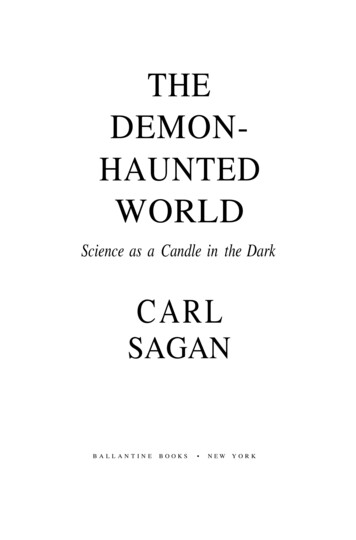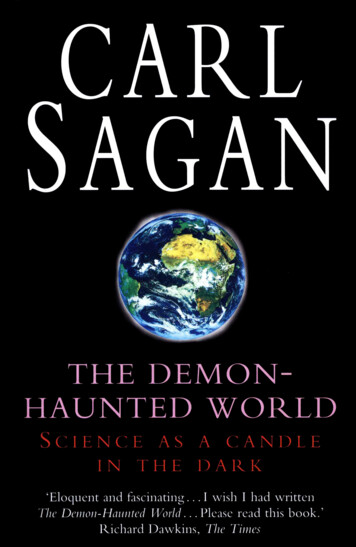
Transcription
NAGPRA, Science, and theDemon-Haunted WorldThe Native American Graves Protection and Repatriation Act (NAGPRA)has ramifications that extend far beyond how archaeology is conducted in the United States.It throws into sharp relief the conflict between science-like views of the world,and those of the various anti- and pseudo-science constituencies arrayed against them.GEOFFREY A. CLARKIn 1990, after two decades of lobbying by Indian activistscritical of the practice of archaeology as a science-likeendeavor, Congress passed into law the Native AmericanGraves Protection and Repatriation Act (Public Law 101601), commonly known as NAGPRA. NAGPRA changedhow archaeology is done in the United States in ways thatwere only dimly perceived at the time by its backers (someIndian political activists, federal and contract archaeologists)and its opponents (mostly archaeologists in academic andmuseum settings). I believe that NAGPRA is basically "antiscience" in terms of the biases, preconceptions, and assumptions that underlie the law and that it proceeds from anantievolutionary perspective grounded in fundamentalist44Mjy/Iune 1999 SKEPTICAL INQUIRER
religious belief. As such, it favors the religious beliefs o f NativeAmericans over those of other Americans, and stands in violation o f the First Amendment to the Constitution.I am a palcoanthropologist and O l d World prehistorianinterested in epistemoiogy—how we know what we think weknow about the remote human past (Clark1992, 1993)- More precisely, I am interestedin the logic o f inference in what I call "deeptime"—the Plio-Pleistoccnc archacopaleontological records o f Africa and westernEurasia (Clark 1997a). I am a different kindo f archaeologist from most o f the peopleinvolved with N A G P R A on a daily basis. Imention this because I think the kind o farchaeology one practices has implicationsfor how N A C P R A is regarded, and whetheror not one is disposed to be sympathetic toit as a mechanism for redressing historicalwrongs. In terms o f my biases, I am a committed evolutionist and, like most evolutionists, a materialist to the core. Thesephilosophical considerations in turn affect Geoffrey A. Clarkhow I view archaeology, and my vision o farchaeology's place within the broader context o f Western science (Clark and Barton 1997).While I readily acknowledge its defects, I am a staunch andunapologeiic admirer o f science. Like it or not, the modernworld is almost entirely a product o f science. Despite unparalleled success, however, science is currently under assault byvarious pseudo- and anti-science constituencies that attack thematerialism that is the central ontological bias o f the scientificworld view Usually considered a "scicncc-likc" cndeavoi,archaeology is caught up in this controversy. Laws like N A G PRA strike at the heart o f a scientific archaeology because theyelevate Indian cultural traditions and religious beliefs to thelevel o f science as a paradigm for describing or explaining reality. Political considerations thus rake precedence over disinterested evaluation of knowledge claims, with tragic and irreversible results (Clark 1996).Because o f my preconceptions about the place o f humans inthe natural world, I think archaeology is, or should be, a "science-like" endeavor—as opposed to a political enterprise, a business (e.g., the "heritage industry"), a platform for promoting asocial agenda, or an exercise in public relations. And I think thatmost American archaeologists, whether or not they acknowledge it publicly, subscribe to exactly the same kinds o f assumptions about the nature o f the world, and the place o f humans init, that underlie all of Western science. The problem is that theyarc forced to compromise their beliefs (or keep silent aboutthem) for the sake o f political expediency.Science and ReligionScience can be defined as a collection o f methods for evaluating the credibility o f knowledge claims about the experientialworld. Science docs not pretend to certainty; it only seeks bet-ter and better approximations o f it. Scientific conclusions arccontinuously subjected to critical scrutiny. Science is, therefore, self-correcting. No topic or question is off-limits to science. The only thing that is antithetical to the scientific worldview is dogma. Dogma is the stuff o f religious belief. From thestandpoint o f science, the illusion o fabsolute, unchanging truth is the most pernicious o f vanities.Physicist Edgar Pearlstein (1997) pointsout that the essential disagreement betweenscience and religion is not in the conclusions(e.g., evolution, the heliocentric solar system,the origin o f disease), but rather in the way ofarriving at conclusions. Religion relies uponauthority (from a book, a person, or tradition) and its truth is claimed to be universal,unchanging, and eternal. In science, authority lies in evidence and reason, which arealways open to challenge, so its truth is alwaysrelative and tentative. Scientific investigationstarts with a question, and tries to find ananswer through strong inference founded onevidence and reason. A theological investigation, on the other hand, starts with a conclusion, and tries towiggle around any impediments o f logic and reason in orderto warrant, or justify, that conclusion (Pearlstein 1997).Evolution and MaterialismThere arc, o f course, many views of humans and their place inthe natural world. I argue, however, that there is only one scientific view—that o f neo-Darwinian evolutionary theory. As themost powerful explanatory framework that humans have everdevised to account for the origins and diversity o f life on Earth,evolution is central to Western science, extends far beyond thelife sciences in which it arose, and subscribes to the same materialist biases and assumptions that underlie all o f science.Materialism is the idea that only matter exists, and thatwhat we regard as " m i n d " or "spirit" consists exclusively o fmatter arranged in complex ways (Gould 1994). More precisely, " m i n d " is a consequence o f brain evolution, and,because our brains have evolved over the 5 million years forwhich we can document the existence o f the Hominidae, whatconstitutes " m i n d " has also evolved. From this perspective,humans are only animals (albeit highly intelligent, technologically sophisticated, socially complex ones). Religious views o fhumans and their place in nature, dependent as they are onconcepts that have no reality outside the mind, arc cpiphe-Geoffrey A. Clark is Distinguished Research Professor ofAnthropology at Arizona State University, Tempe AZ 852872402. This essay is derivedfrom NAGPRA symposia presentationsat the annual meetings of the American AnthropologicalAssociation (Washington, D. C. in November of 1997) and theSociety for American Archaeology (Seattle. Washington, in Marchof 1998). E-mail: gaclark@asu.edu.SKEPTICAL INQUIRER May/June 199945
nomena (and—for a materialist—absurd). Despite our veryconsiderable capacity for compartmentalization (see, for example, Estling 1998), one cannot simultaneously understand andaccept evolution and its philosophical underpinnings, and sustain a belief in the nonmaterial. From the standpoint of science, religious beliefs are curious survivals of earlier cognitiveevolution (e.g., Mithen 1997a,b). As our cognitive capacitiesexpanded slowly over the long millennia of the Pleistocene, wecame to imagine more and more complex realities, and populated them with the gods, demons, and spirits that are the stuffof conventional religious belief. Religious tenets and precepts(especially those dealing with morality and ethics) are ex postfacto rationalizations for existing social conditions. To theextent that they converge cross-culturally and through time, itis because they reflect universal aspects of human social life.To recapitulate, (1) philosophical and methodologicalmaterialism underlies the scientific world view, (2) the scientific world view regarding humans is grounded in Darwinianevolutionary theory (Scott 1997), (3) archaeology is "sciencelike" in terms of the preconceptions that underlie its logic ofinference and its knowledge claims, and (4) this world viewputs those archaeologists who worry about such things at oddswith the antimaterialist belief systems of Indians (and those ofAmericans in general). NAGPRA is, therefore, only a verysmall pan of a much larger controversy that extends to manyaspects of modern American life. That controversy turns onthe conflict between the world views of science and religion.Carl Sagan summarized the issues underlying this debate inThe Demon-Haunted World—recommended reading for scholars of all persuasions, regardless of their views on NAGPRA(1996; sec also Sagan and Druyan 1992).What Is NAGPRA About?NAGPRA is basically about the repatriation to Native Americanclaimants of human remains and funerary objects from museumor federal agency collections, and those recovered from Indianlands (Ferguson 1996). These remains, in the United States andelsewhere, are viewed by science to pertain to a generalizedhuman past, to be part of a universal heritage not circumscribedby ethnic or cultural boundaries. However, legislation enacted inrecent years has given the cultural traditions and religious beliefsof Indians greater weight under the law than the universalis! perspective that underlies scientific inquiry. Motivated by politicalexpediency, and the kind of anti-science sentiment to which Ihave just alluded, NAGPRA requires the consultation in archaeological excavation of very broadly defined Native Americanconstituencies. It also mandates the repatriation and reburial, ifso desired by native claimants, of human remains and funeraryobjects, sometimes including those not affiliated with anyknown or recognized Native American group.The (Mostly) Rotten Fruits of NAGPRANAGPRA creates both short-term opportunities and long-termproblems for archaeologists, bioarchacologists, and for those46May/June 1999 SKEPTICAL INQUIRERbranches of physical anthropology concerned with the study ofhuman skeletal remains. It creates opportunities (1) because theNAGPRA-mandated inventories employ many archaeologistsand physical anthropologists (albeit temporarily); (2) because ithas forced the profession to clean up its act regarding curationand record keeping, and (3) because minimum descriptivestandards are being applied to the human skeletal collections(Rose et al. 1996). It creates problems because NAGPRA putsethnicity and religious belief on an equal footing with science,and thus provides a mandate for claims of affiliation by virtually any interested party. As is true of any ethnic or racial category, however, "Native Amcricanncss" has only a political definition. Anthropologists acknowledge the statistical, clinal character of race and ethnicity; the government does not (Clark1998a). Federal agencies and state legislatures, which haveoften gone far beyond NAGPRA in their zeal to be politicallycorrect, don't want to be bothered with such subtleties (after all,anthropologists are an even weaker political constituency thanIndians). The result is that claims for the repatriation of humanremains and "objects of cultural patrimony" can be extended toinclude just about anything identified as "affiliated" by aclaimant. The process thus becomes entirely political, with science, represented by archaeology, the inevitable loser.Physics Envy and Archaeology's Many AnxietiesArchaeology is admittedly a "small science," only weakly developed conceptually and characterized by few of the powerfullaw-like generalizations that underlie the spectacular progress ofmainstream, experimental "big science" disciplines like physics.Despite its many shortcomings, however, archaeology in theUnited States has always been a "science-like" endeavor in thesense that it subscribes to the same collection of materialistbiases and assumptions that underlie all of science. Moreover,its achievements have been substantial. We are all the losers if,for reasons of political expediency, Indians rebury their past.One of the many ironies in the situation provoked by NAGPRA is that many Native American groups who favor thepreservation of archaeological and skeletal collections are beingco-opted by the actions of small, but vocal, activist minoritiesin cahoots with ignorant legislators willing to sell the professiondown the pike for the sake of short-term political gains.Operationalizing NAGPRA ProvisionsIn addition to the conceptual problems, there arc also problems with operationalizing NAGPRA. These are thrown intosharp focus by the ridiculous situation surroundingKennewick Man, a 9,300-ycar-old human skeleton withallegedly "non-Indian" affinities found eroding out of a cutbank on the Columbia River near the town of Kennewick,Washington, in 1996 (see, for example, Morell 1994, 1998).Kennewick Man is the focus of a bitter controversy that pitsNative American religious beliefs against archaeologists' stillevolving theories about human colonization of the NewWorld, and clearly has considerable scientific importance. But,
under their construal of NAGPRA, the U.S. Army Corps ofEngineers, which has jurisdiction over the site, wants to turnthe skeleton over (o the Umatilla Tribe of northeastern Oregonfor rcburial, with no scientific evaluation of its significance—in fact, no study at all. 1 his effort has been blocked—temporarily, at least—by a lawsuit by eight prominent anthropologists. The case is still in court.mately a religious one (for example, Hopi origin myths areinvoked to claim control over human remains from roughly 20percent of the continental United States). That intelligent,well-educated people cannot sec the problems with this is dinin my opinion, to ignorance of evolutionary biology (archaeologists usually have little or no exposure to this field), and,more generally, to the human tendency to compartmentalizeAlthough by no means unique.Kennewick Man underscores a fatal flawRace and ethnicity are fleeting transient things.in NAGPRA, which is predicated on theassumption that anthropologists can inThe notion of fixed enduring, bounded ethnicityfact identify prehistoric antecedents tois positively quaint from the perspective ofextant identity-conscious social groups.However, anyone reasonably familiar withmodern population biologyevolutionary biology would recognizethinking. We shift referential and conceptual formats whenimmediately that they cannot do that reliably or consistently.we're talking or writing about science, religion, politics, ecoRace and ethnicity are fleeting, transient things. They arc writnomics, etc., with little cross-linkage amongst these intellecten on the wind. They do not partake of the timelesstual domains (Clark 1987)."essences" the public, in its lack of understanding of biologyand culture, would impart to them (Clark 1997b,c). There isno basis in science for thinking that present-day ethnic groupseven existed zs recently as 400 or 500 years ago, much less inmore remote time ranges. The notion of fixed, enduring,bounded ethnicity is positively quaint from the perspective ofmodern population biology (sec, for example, Wolpoff andCaspari 1997, Molnar 1998). Nevertheless, it is endorsed andreified by the type of thinking institutionalized in public policy by our own government. If you arc inclined to be skeptical, look sometime at the absurd racial and ethnic categoriesconcocted by the U.S. census and replicated on applicationforms throughout the land (Clark 1997c, 1998b). Indianclaims for ancient skeletal remains based on assertions of ethnic relationship, geographical proximity, or historical connection grounded in "pan-Indianness" are without foundation.Popular conceptions of race and ethnicity as discrete orbounded entities have no basis in modern science (AAA1998). Consequently, efforts by anthropologists to trace memback very far into the past are likely to be doomed to failure.Anthropologists have been, and will continue to be, alliedwith Indians in their quest for social justice and in efforts toimprove the socioeconomic conditions of their existence.From the liberal philosophical standpoint to which I—andmost anthropologists—subscribe, this is as it should be.However, obstacles to this alliance are created by a simpleminded essentialism that pervades the whole discussion of raceand ethnicity in the U.S.—an essentialism that permeates theNAGPRA debate and that has, or should have, no place in thescientific world view. While I am sympathetic to the socioeconomic concerns of Native Americans, I have little patiencewith, nor sympathy for, the contention that races and ethnicgroups are somehow "fixed" and immutable, bounded in spaceand time. The fact that "the oppressed" (i.e., Indians) subscribe to the same essentialist notions of ethnicity as "theoppressors" (i.e., the government, or Americans in general)doesn't mean that these notions arc scientifically credible(Clark 1997b,c; 1998a). The justification for NAGPRA is ulti-Wreaking Vengeance on HistoryNAGPRA is an attempt to redress historical wrongs by givingIndians a voice in the disposition of the remains of their ancientforbearers. However well-intentioned, the law was quickly coopted by what might be called Indian creationists who haveinvoked, often successfully, a revealed wisdom in respect of theirorigins that is not to be challenged, questioned or investigatedin any way (Egan 1996, Meighan 1996). These claims do notdiffer in kind or in detail from those embodied in the JudacoChristian origin myth (i.e., the Book of Genesis).No one disputes that Indians have suffered mightily at thehands of the European colonists who came to dominateAmerican society. No one is arguing that scientists have alwaysacted responsibly in respect of human skeletal material undertheir curation. No one is suggesting that if wc can just somehow"decode" nature correctly, that moral truth will be revealed. Yetthe loss of prehistoric skeletal material to science is incalculable,and that consideration should take precedence, in my view, overthe religious concerns of Native Americans. The world views ofscience and religion arefundamentally incommensurate. They cannot be reconciled. Science is not about religion, however.Science is not about moral truth, although it can sometimeshelp us in our struggle to reach moral decisions (Gould 1994).Clearly, humans did not evolve in this hemisphere. Indianshaven't "always been here," haven't always been where they artfound today, regardless of what their origin myths might say. Iam curious as to how they came to be here, and what happened to them subsequent to their arrival. The best way (infact, the only way) to get at these questions is through theanalysis of prehistoric human skeletal material. The idea thatwc should spend a bundle of money now to study it likecrazy—before wc give it back—is ridiculous on the face of it.since it presupposes that science will not advance, and thatnew avenues of inquiry will not be opened to us. It alsoassumes that data exist independent of the conceptual framc-SKEPTICAL INQUIRERMay/June 199947
1997c. Pernicious vanities. Anthropology Newsletter 38:54, 56.1998a. NAGPRA, religion and science. Anthropology Newsletter39:4, 5.1998b. Fixin' racism. Anthropology Newsletter 39:7'.Clark, G. A. and C. M. Barton. 1997. Rediscovering Darwin. In RediscoveringDarwin: Evolutionary Theory and Archeological Explanation (C. Barton andG. Clark, eds.). Washington: Archeological Papers of the AmericanAnthropological Association No. 7, pp. 309-319.Egan, T 1996. Tribe stops study of bones that challenge its history. The NewYork Times. September 30, 1996.Estling, R. 1998. Gimme that ol'-timc logical consistency. SKEPTICAL INQUIRER22:58, 59.Ferguson, T. J. 1996. Native Americans and die practice of archaeology. AnnualReview of Anthropology 25:63-79.Gould. S. J. 1994. Darwin's Revolution in Thought. Northampton, Mass.: Intothe Classroom Video, Inc.Meighan, C. 1996. Quoted in Indian creationists thwart archaeologists (G.ReferencesJohnson). The New York Times. October 22. 1996.Mithen, S. 1997a. The Prehistory of the Mind. London: Thomas & Hudson.AAA (American Anthropological Association). 1998. AAA sraiemcni on "race."1997b. Cognitive archeology, evolutionary psychology, and culturalAnthropology Newsletter 39(6):3.Clark. G.A. 1987. Paradigms and paradoxes in comemporary archaeology. Intransmission, with particular reference to religious ideas. In RediscoveringQuantitative Research in Archaeology: Progress and Prospects (M. Aldenderfer,Darwin: Evolutionary Theory in Archeological Explanation (C. Barton and G.ed.). Beverly Hills: Sage Publications, pp. 30-60.Clark, eds.). Washington: Archeological Papers of the American1991. Introduction. In Perspectives on the Past: Theoretical Biases inAnthropological Association No. 7, pp. 67-74.Molnar, S. 1998. Human Variation: Races. Types and Ethnic Groups. UpperMediterranean Hunter-Gatherer Research (G. Clark, ed.). Philadelphia:University of Pennsylvania Press, pp. 1—21.Saddle River, New Jersey: Prentice-Hall.1992. Continuity or replacement? Putting modern human origins in anMorell, V 1994. An anthropological culture shift. Science 264:20-22.evolutionary context. In The Middle Paleolithic: Adaptation. Behavior and1998. Kennewick Man's trials continue. Science 280:190-192.Variability (H. Dibble & P Mellars. eds.). Philadelphia: University ofPearlstein. E. 1997. Science and religion. Science 279:1591 (original text).Rose, J., T Green and V Green. 1996. NAGPRA is forever: Osteology and thePennsylvania Museum, pp. 183—205.1993. Paradigms in science and archaeology. Journal of Archaeologicalrepatriation of skeletons. Annual Review of Anthropology 25:81-103.Sagan, C. 1996. The Demon-Haunted World: Science as a Candle in the Dark.Research 1:203-234.New York: Ballantine Books.1996. NAGPRA and the demon-haunted world. SAA Bulletin 14:3,Sagan, C. and A. Druyan. 1992. Shadows of Forgotten Ancestors. New York:15:4.1997a. Through a glass darkly: conceptual issues in modern human oriRandom House.gins research. In Conceptual Issues in Modern Human Origins Research (G. Scott, E. 1997. Antievolutionism and creationism in the United States. AnnualClark & C. Willermet. eds.). New York: Aldine dc Gruyter, pp. 60-76.Review of Anthropology 26:263-289.1997b. Race from the perspective of western science. AnthropologyWolpoff, M. and R. Caspari. 1997. Race and Human Evolution. New York:Newsletter 38:54.Simon and Schuster.Dworks that define and contextualize them, which, from anepistcmological standpoint, is terminally naive (Clark 1991).Most of what passes for intelligent discourse about NAGPRAconsists of what I would call "psychodrama," and betrays anear-total ignorance of evolutionary biology on the part ofnearly all concerned. Psychodrama is the stuff of religiousbelief (and politics), and has no place in science. A direct consequence of the national paroxysm of guilt surrounding thequincentenary, NAGPRA is bad law. It is in the interests ofIndians and Anglos alike that it be repealed.BITTER HARVESTfrom page 39urban legends. T h e term for the phenomenon is "source amnesia." It occursbecause factual information is apparently stored in a different part of thebrain than the source of that information. So while the information itself isretained, the source may be misremembcred or lost, and of course the sourceis essential for determining the credibility of the information.2. Some of the body parts mentioned here, such as corneas and fat, arcnot organs. T h e distinction is important because corneas, as nonvascular tissue, need not be implanted in a recipient immediately. They remain viablefor between one and two weeks, while a kidney must be implanted withinapproximately two days. Because of this, claims that kidneys are taken fromrural areas in Latin America and shipped to Europe, for example, arc highlysuspect; the kidneys would likely be unusable when they arrived. In the caseof fat theft, the usual reason for the harvesting is nor transplanting, so suchconsiderations are not applicable.ReferencesBarry, John, and David Schrieberg. 1995. Too Good to Check. Newsweek. June26.Brooks, Alison. 1993. Frankenstein stalks the urban jungle. New Scientist, 23January.Brunvand. Jan Harold. 1993. The Baby Train and Other Lusty Legends. NewYork: W W . Norton.Cahill, Tim. 1995. A darkness on the river. Outside magazine November.Campion-Vincent. Veronique. 1990. The Baby-Parts story: A new LatinAmerican legend. Western Folklore 49:9-25.Canto. Minerva. 1994. Rumors nearly killed N . M . traveler. AlbuquerqueJournal 17 April.Chavez. Eulogio. 1996. Personal interview with the author.Cohen. Lawrence. 1998. Quoted in Scheper-Hughes. Nancy.Forbes, Michael- 1998. Cardinal helps spread child organ-trafficking myth.48May/June 1999 SKEPTICAL INQUIRERColony Guadalajara Reporter. 4 July.Ferrari, Eric. 1998. Urban legends pick up steam on the Internet. Buffalo News15 April.Kidney-napping: India's Organ Thieves. 1995. Details June, p. 36. (No authorcited).Leventhal. Todd. 1994. The child organ rrafficking rumor: A modern "urbanlegend." U.S. Information Agency Report to ihe United Nations SpecialRapporteur. Washington D.C.: U.S. Infotmarion Agency.Mikkelson, Barbara and David P. Mikkelson. 1998a. You've got to be kidneying. Urban legends reference page. Web site: http: snopes.simplenet.com. 1998b. Personal correspondence.Morello, Carol. 1994. Baby theft panic cools Guatemalan tourism, adoptions.Albuquerque Journal. 17 April.Orlebar, Edward. 1994. Guatemalan army may be fueling fire. AlbuquerqueJournal, 3 January.Radford. Benjamin. 1996. Lik'ichiri: menace or myth? Bolivian Times') May.Scheper-Hughcs, Nancy. 1998. Trurh and rumor on the organ trail. NaturalHistory, October.Schramm. Raimund. 1988. Monstrous dormidos. heroes cururales y plantasen creefmiento. Bibiloteca Ethnologia. Boliviana: Cochabamba.Shakespeare. 1989. Quoted in Campion-Vincent 1990.Sifuentes, Eudosio. 1989. La continuidad dc la historia dc los pishracos en los"robaojos" dc hoy. In Pishtacoi de verdugos a sacaojos. Juan Ansfon. Ed.Tarea, Asociacion de Publicaci6nes Educativas: Lima. Peru.Sleeman, James. 1997. Unridcd letter to magazine. Planet Talk. OctoberDecember.Sottas. Eric. 1994. Trade in organs and torture. Presentation and report forEurosciences Media Workshop. Geneva. Switzerland: World OrganizationAgainst Torture.Velasquez. Zenobio Calizaya. 1994. Liquichiris y k'arisiris su rclauon con lospueblos prc-aymaras. In Education Bilingue E lntercultural Reunion Anualde Etnologta 1994. Tomo 1. Museo National de Emologia y Folklore:Lima. Peru.Wallich, Paul. 1998. This is not a hoax! (Cyber View column). ScientificAmerican. November.LJ
Demon-Haunted World The Native American Graves Protection and Repatriation Act (NAGPRA) has ramifications that extend far beyond how archaeology is conducted in the United States. It throws into sharp relief the conflict between science-like views of the world, and those of the various anti










